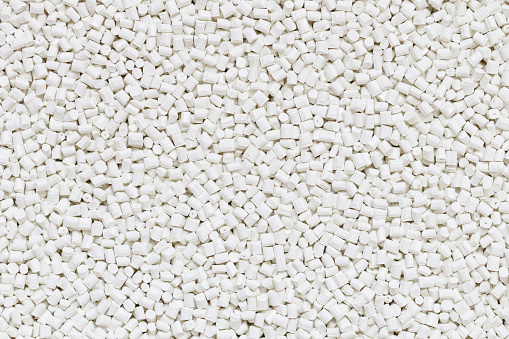
(1) Modified filling
Filling masterbatch is to reduce production costs as the main purpose, mostly using inorganic powders or industrial waste at low prices and from a wide range of sources as filling materials, and add the right amount of additives and synthetic resins to produce.
Heavy calcium carbonate filler masterbatch is a widely used filling modification material in the plastics industry, with manufacturers all over the country and an annual output of over 5 million tons.
(2) Modified masterbatch
Modified masterbatch is a new modified material developed on the basis of filled masterbatch.
Add glass fiber, talc, mica, wollastonite, barium sulfate, kaolin and other inorganic materials in the resin, or add synthetic resins or additives with special properties in the processing, such as: anti-aging agents, antioxidants, flame retardants and other additives or POE, EVA, etc., these composite materials in the application of the functional characteristics of different materials.
Such as car bumpers, instrument panels, car interior decorative parts, etc., using PP talcum powder, with the advantages of increasing impact strength, improving the bending modulus, reducing shrinkage, reducing the loss of rigidity caused by vehicle impact.
(3) Functional modification
Plastics with graphene, silicone powder, rare earths, magnesium hydroxide, metal microfine powder (silver, copper, zinc, etc.) and a variety of different materials, through the modification technology to improve product indicators, flame retardancy, ageing resistance, high and low temperature resistance and other physical properties are improved, but also to achieve electrical conductivity, antibacterial, insulation, enhancements and other special properties, has taken a place in the main durable plastic products market.
(4) Multi-composite modification
Multi-composite modification is mainly through the plastic “alloying” method, the plastic and one or more inorganic materials, polymer materials, chemical additives, etc., through blending, grafting, blocking and other forms of combination together, so that the performance of each component to complement each other, constitute a variety of excellent performance of plastic materials, so as to improve performance and multi-functionalisation. These material “alloys” used in high-tech industry, with light quality, high strength, excellent performance and other characteristics, become aviation, aerospace, automotive, railway, machinery parts, medical materials and other aspects of the new functional materials.
(5) Special modification
In the special plastic to add different functional materials or additives, so that the expensive special plastic both to maintain the original characteristics, but also has a special function, to adapt to a variety of product market applications.
Such as polyphenylene sulfide (PPS), polyimide (PI), polyether ether ketone (PEEK), polysulfone (PSF) and liquid crystal polymer (LCP) and other high-performance resins, adding carbon fiber, graphene, liquid crystal polymers, rare earths and other different materials, with good electrical properties, high temperature resistance, dimensional stability and special flame retardancy, radioactive resistance, chemical resistance and mechanical properties, these modified new materials in These modified new materials have increasingly important application areas in the fields of electronics and electrical appliances, automobiles, home appliances, aviation, petrochemicals and cutting-edge technologies such as rockets and astronautics.











